Once again we have reached the point where the areas of our garden we leave wild at the start of the year need taming. I always leave a large patch of comfrey at the bottom of the garden as it is such a good source of early nectar for bees and pollinators, but this pretty, although prickly irritant of a plant, romps away and before you know it, everything has been swamped. 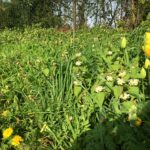 Now that the bulk of flowering is over I have begun to reduce the area by at least half – and found a lovely surprise under it all – a patch of wild garlic which I had no idea was there. Next to the fenced grass pile (which has been phenomenal at giving us mulch at this time when garden centres have been closed) there peered up at me some rather light-deprived wild garlic; rather sorry leaves but lovely delicate white flowers. I am hoping it will recover now that it is not weighed down by comfrey and I might try transplanting some to a place a little easier to get to and keep clear.
Now that the bulk of flowering is over I have begun to reduce the area by at least half – and found a lovely surprise under it all – a patch of wild garlic which I had no idea was there. Next to the fenced grass pile (which has been phenomenal at giving us mulch at this time when garden centres have been closed) there peered up at me some rather light-deprived wild garlic; rather sorry leaves but lovely delicate white flowers. I am hoping it will recover now that it is not weighed down by comfrey and I might try transplanting some to a place a little easier to get to and keep clear.

At the same time, I had to re-find the access to the grass pile as the hedge next to it had bulked out somewhat. A lot of people will think I am mad, but I always cut my hedging back by hand with secateurs (although MOTH does do the hedge at the front but only after I’m convinced nesting season is over). Cutting by hand may take longer but to me it feels so much kinder and less intrusive and I am more convinced of that now as, once more, I was given a wonderful surprise. As I edged along gently taking pieces of hedging away, I came across a well-hidden nest with four beautiful small bright blue eggs – a dunnock’s nest. 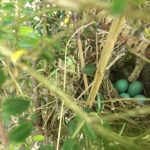 Naturally, I immediately backed off and I am happy to report that I have seen an adult on the nest since, so I am no longer worried about having disturbed it.
Naturally, I immediately backed off and I am happy to report that I have seen an adult on the nest since, so I am no longer worried about having disturbed it.
The line between gardening for us and for nature is weighted heavily in favour of nature at the front of our house too (much to the neighbours’ horror I’m sure; those that allow nothing for wildlife save an extremely mowed lawn).
We always get a bit of a meadow of dandelions and do you know what – I leave them. The bright yellow is simply gorgeous to see and they are great for pollinators. When their heads turn to clocks, I still can’t get rid of them because when I look out I can see many goldfinches perched on the stems pecking away at the seeds that are attached to the iconic, delicate parachutes. I was watching a line of goldfinches on the telephone wire connected to our house the other day and they were themselves acting like parachutists. All in a row, one by one they dropped off, straight down to the awaiting dandelions below.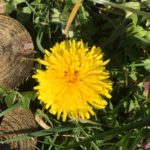
As an aside, did you know that the name dandelion comes from the French, ‘dent- de lion’ – lion’s tooth, although, apparently this is not what the French call it, their name for dandelion is pissenlit. The attached name ‘clock’ which appears when the head dries and turns to delicate seeds, has its root in an old bit of folklore when to divine how long you had left to live, you would blow upon the clock and count how many seeds still remained attached.
The song thrush is in full evidence – but this time, not only in its absolutely bonkers song; the garden is littered with smashed empty snail shells, the remains of the mollusc homes left in pieces on paving stones and large rocks. And it is no surprise there are so many takeaway shells about, because we now have two thrushes, the juvenile of which is often hopping about the pots on the patio looking exceedingly pretty and plump.
More elusive birds this week have been the stunning kite that occasionally does a fly-by over the house but which never hangs around long enough to be captured on camera other than as a tiny speck in the blue and also the unseen cuckoo whose call I heard this week for the first time of the year. 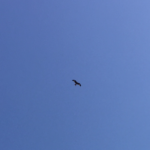
The enormous and increasing number of wood pigeons however, I shall not be waxing so lyrical about, although one did entertain me the other day be seeming to get stuck on the second part of its infamous call: whoo whoooo hoooo hoo-hoo, hoo-hoo, hoo-hoo hoo-hoo, hoo-hoo…
The house martins are about more, flashing their white stomachs as they zip about aerial feeding, I saw a swallow sat on a telephone wire over a field, the great tits with their Pulp Fiction ties are feeding heavily again, the male blackbirds are scrapping at every opportunity and we have two plump juvenile blackbirds always bobbing about the garden together, rotund and with thin little legs, they remind me of Tweedle-dee and Tweedle-dum; the garden is busy!
But I promised you rhubarb, and if only I could actually give it to you. There was a rhubarb patch here when we moved in. Not being the biggest fans of the vegetable, I have tried to remove it several times; believing last year that I had finally succeeded – but no; it lives again, rising from the earth with 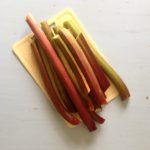 triumphant red arms, defiantly waving enormous leaves at me. And so, as I write this, I have a huge amount of rhubarb chutney simmering away as well as three crumbles ready for the freezer. It is the spider plant of the garden – un-killable!
triumphant red arms, defiantly waving enormous leaves at me. And so, as I write this, I have a huge amount of rhubarb chutney simmering away as well as three crumbles ready for the freezer. It is the spider plant of the garden – un-killable!